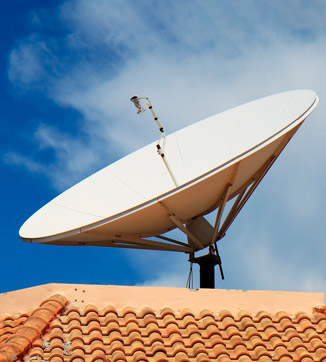Satellite dishes are devices designed to receive high-frequency radio or television signals.
Contents
Definition of parabolic antennas
They consist of a reflecting surface in the form of a parabola and a receiving element located at the focus of the parabola. These antennas are mainly used for the reception of signals from artificial satellites, but are also used in some terrestrial applications.

Importance of satellite dishes in modern communications
The main function of a dish antenna is to pick up the radio frequency signals emitted by satellites and focus them towards the receiving element. The reflecting surface, which is usually made of metal, is shaped like a parabola to direct the incident radio waves towards the focus of the parabola, where the receiver is located. This parabolic shape allows for greater sensitivity and better focusing of the signals, which results in better reception quality.
Satellite dish applications
Satellite dishes are used in a variety of applications, one of the most common being the reception of satellite television signals. These antennas make it possible to receive television channels and broadcast services directly from satellites in space.

Long distance telecommunications
They are also used in telecommunications applications, such as long-distance point-to-point communication links. In these cases, satellite dishes are used to transmit and receive voice, data and high-speed video signals.
Voice and data transmission
The transmission of voice and data via satellite dishes is based on the principle of modulation and demodulation of signals. Voice and data signals are converted into radio frequency signals by a modulation process. These modulated signals are transmitted from a ground station via the satellite dish to the satellite in space.
Once in space, the satellite receives the signals and retransmits them to another ground station at the destination point. At the receiving ground station, another dish is used to pick up the signals transmitted by the satellite. These signals are demodulated, i.e. the original voice and data signals are recovered, so that they can be used by end-users.
The transmission of voice and data via satellite dishes offers several advantages. Firstly, it allows long-distance communication without the need to extend cables or expensive terrestrial infrastructure. This is especially useful in remote areas or areas with difficult terrain, where the installation of cables would be complicated or impractical.
Point-to-point communication links
In point-to-point communication links, two dish antennas are used: a transmitting antenna and a receiving antenna. These antennas are located at the source and destination points of the communication. The transmitting antenna emits radio frequency signals that are focused and transmitted through space to the receiving antenna, which captures and demodulates them for use.
These point-to-point communication links are used in a variety of applications. For example, they are used in the telecommunications industry to establish links between distant corporate offices, enabling internal communication and data exchange in a secure and efficient manner.
Installation of satellite dishes
The installation of a satellite dish requires certain technical knowledge and skills. A professional installer is usually hired to ensure that the dish is installed correctly and properly adjusted. The installer will determine the optimal location for the dish, usually in a place with a clear view of the sky and no obstructions that could block the satellite signal.
Importance of proper installation
Once installed, the dish must be correctly aimed towards the desired satellite. This involves adjusting the direction and tilt of the dish so that it is aligned with the orbital position of the satellite. To make this adjustment, compasses, levels and signal measuring equipment are used to ensure accurate alignment.
Hiring a professional installer
The main use of satellite dishes is for the reception of signals from artificial satellites and they have applications in both satellite television and telecommunications. It is important to note that their installation and adjustment requires technical expertise, and a professional is usually hired to perform this work. It is important to comply with local regulations and restrictions when using satellite dishes.
Optimal location for the satellite dish
Choosing the right location to install a satellite dish is crucial to ensure optimal signal reception. Incorrect location may result in a weak signal, interference or signal blockage, which would negatively affect the quality of reception.
When selecting the location for the satellite dish, the following factors should be considered:
Visibility of the sky: The satellite dish should be located in a place with a clear view of the sky, without obstructions such as trees, tall buildings or structures blocking the satellite signal. The larger the field of view to the sky, the better the signal reception.
Orientation towards the satellite: It is important to know the orbital location of the satellite to which you want to point the antenna. With this information, you can determine the proper direction and tilt angle to orient the antenna correctly. You can use tools such as compasses or smartphone applications that provide information about the satellite’s position.
Electromagnetic interference: Avoid locating the dish near sources of electromagnetic interference, such as power lines, transformers, mobile phone antennas or other electronic devices that may generate noise or signal interference.
Stability and safety: The satellite dish should be installed in a safe and stable location. It should be firmly fixed to the ground or to a solid structure to withstand adverse weather conditions, such as high winds or rain.
What do I need to watch TV with a satellite dish?
In order to watch TV using a satellite dish, you will need the following items:
Satellite dish
The satellite dish is the main component that will pick up satellite TV signals. Its curved dish shape allows it to reflect and focus the signals towards the reception point.
LNB (Low Noise Block)
The LNB is a device located at the front end of the satellite dish. Its function is to receive the signals reflected by the antenna, convert them into electrical signals and amplify them. It also reduces signal noise to improve reception quality.
Satellite receiver
The satellite receiver is the device that receives the electrical signals from the LNB and decodes them to display the TV content on your screen. It is connected to the TV via audio and video cables or an HDMI connection for better picture quality.
Coaxial cable
Coaxial cable is used to connect the satellite dish to the LNB and carry the TV signals from the dish to the satellite receiver. It is important to use a good quality cable to minimise signal loss during transmission.
Decoder card or subscription
Some satellite TV services require a decoder card to access channels. This card is inserted into the satellite receiver and allows decoding of encrypted signals. In addition, you may need an active subscription with the satellite TV provider to access channels and content.
TV
Obviously, you will need a TV set to watch the TV channels transmitted through the satellite dish. Make sure your TV has the necessary connection ports to connect the satellite receiver, either through audio and video cables or an HDMI connection.







